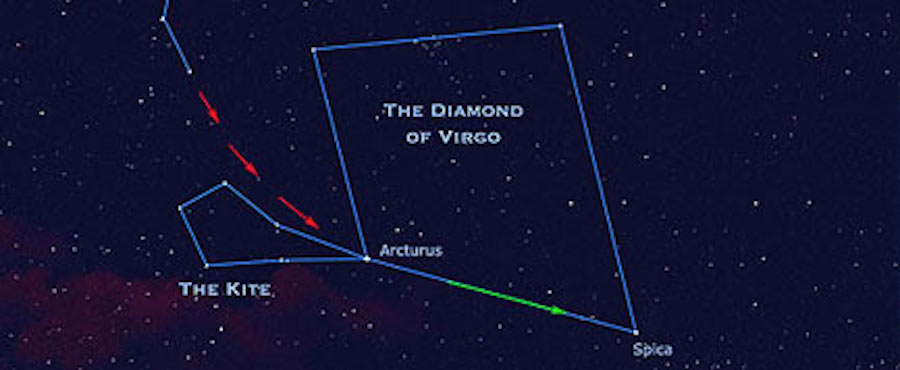
Thereis a brilliant star that sparkles with a golden yellow or topaz hue, positionedhalfway from the eastern horizon to the point directly overhead (the zenith) asdarkness falls this week. It?s Arcturus, and it resides in the constellation ofBo?tes, the Herdsman.
Arcturusranks as the fourth brightest star in thenight sky overall, behind Sirius, Canopus and Alpha Centauri. In olderastronomy books, it was ranked sixth behind Vega and Capella, but modernmeasurements have since shown it to be a trifle brighter than those two stars.
Asif it weren't already easy enough to find, there is another way of locating it.
Lookat the Big Dipper. Its handle is bent. Imagine extending a curve from the handle;a curve that is readily translated into a smooth arc. Continue that imaginaryarc about the length of the Big Dipper and you will ultimately come toArcturus.
Soremember: "Follow the arc to Arcturus." Somefolks may add an additional line: "Then speed to Spica," forthat same arc, continued past Arcturus for roughly the same distance, will cometo the bright bluish star Spica in the constellation of Virgo.
Arcturusis estimated to be roughly 25 times the diameter of the Sun — about 20 millionmiles. Its luminosity is about 115 times that of the Sun. In his definitivethree-volume work "Burnham's Celestial Handbook," Robert Burnham, Jr.points out that with modern infrared recording devices, the heat received fromArcturus can be measured, and is found to "... equal the heat of a singlecandle at a distance of about 5 miles."
Time travel
Breaking space news, the latest updates on rocket launches, skywatching events and more!
Itwas 77 years ago this month, on May 27, 1933, that Arcturus became the objectof a great publicity buildup in Chicago, at the opening of the Century ofProgress Exposition. At 9:15 p.m. Central Time that night, the star's light wasfocused by telescopes on photoelectric cells, and the current generated wasused to activate the switch to turn on the floodlights at the expositiongrounds.
Arcturus waschosen for this task because Chicago had a great World's Fair in 1893. The bestestimates at that time said that the light from Arcturus required 40 years toreach Earth. So a story was built around the fact that the 1933 fair would beopened by light that had started its trip while the 1893 fair was still inprogress.
Ourmore accurate measurements today place the light-time distance of Arcturus at37 years. So it was really starlight that started toward Earth in 1896 thatturned on the lights of the 1933 fair.
Shifty star
Starsare typically said to maintain relatively fixed positions in the heavens. Butthey all move in respect to our vantage point, some much more than others.
Arcturusappears to shift its "fixed" position in the sky much more rapidlythan most of the other bright stars, the sole exception being Alpha Centauri.Edmund Halley was the first to discover this motion back in 1718.
Arcturusappears to whiz through space at a speed of nearly 90 miles per second in thedirection of the constellation Virgo. It appears to move toward Virgo by aboutone-degree (which is about twice the apparent width of a full Moon) over a timespan of about 1,500 years. We are thus very fortunate to live at a time whenthe distance separating Arcturus and our solar system is nearly at its minimum.
Thestar will continue to approach the Earth for several thousand years more, butthen it will pass us as it continues to move toward Virgo and its distance fromus will begin to steadily increase. Computations show that in approximately500,000 years, it will probably have moved out as far as 800 light-years awayfrom us and likely will have faded completely from naked-eye visibility.
Arcturus'home, the constellation Bo?tes, hasits own story.
Thedots over the second "o" in Bo?tes mean that you should pronounce thevowels separately: Boo-OH-tes, not (as many people say) Boo-ties! It is a Greekword meaning a man who tends to a herd of cows, so why not refer to Bo?tes asthe cowboy of the sky?
Inthe allegorical sky pictures of star atlases of a few hundred years ago, Botesis usually pictured holding a large rod or staff. Bo?tes is supposedly chasingafter Ursa Major, the Great Bear. This is why some legends refer to Bo?tes as"The Bear-guard."
Onour sky map Bo?tes resembles a narrow kite, but it might also be envisioned asan ice-cream cone. At the bottom of the cone shines Arcturus. Since it has anorange hue, we might say that the cone was holding orange sherbet, and perhapssomebody bit off the bottom of the cone allowing the last little glob(Arcturus) to dribble out.
- Spotting Spaceshipsfrom Earth
- The Brightest Starsin the Sky
- Gallery — Stars andGalaxies
Joe Raoserves as an instructor and guest lecturer at New York's Hayden Planetarium. Hewrites about astronomy for The New York Times and other publications, and he isalso an on-camera meteorologist for News 12 Westchester, New York.

Joe Rao is Space.com's skywatching columnist, as well as a veteran meteorologist and eclipse chaser who also serves as an instructor and guest lecturer at New York's Hayden Planetarium. He writes about astronomy for Natural History magazine, Sky & Telescope and other publications. Joe is an 8-time Emmy-nominated meteorologist who served the Putnam Valley region of New York for over 21 years. You can find him on Twitter and YouTube tracking lunar and solar eclipses, meteor showers and more. To find out Joe's latest project, visit him on Twitter.
